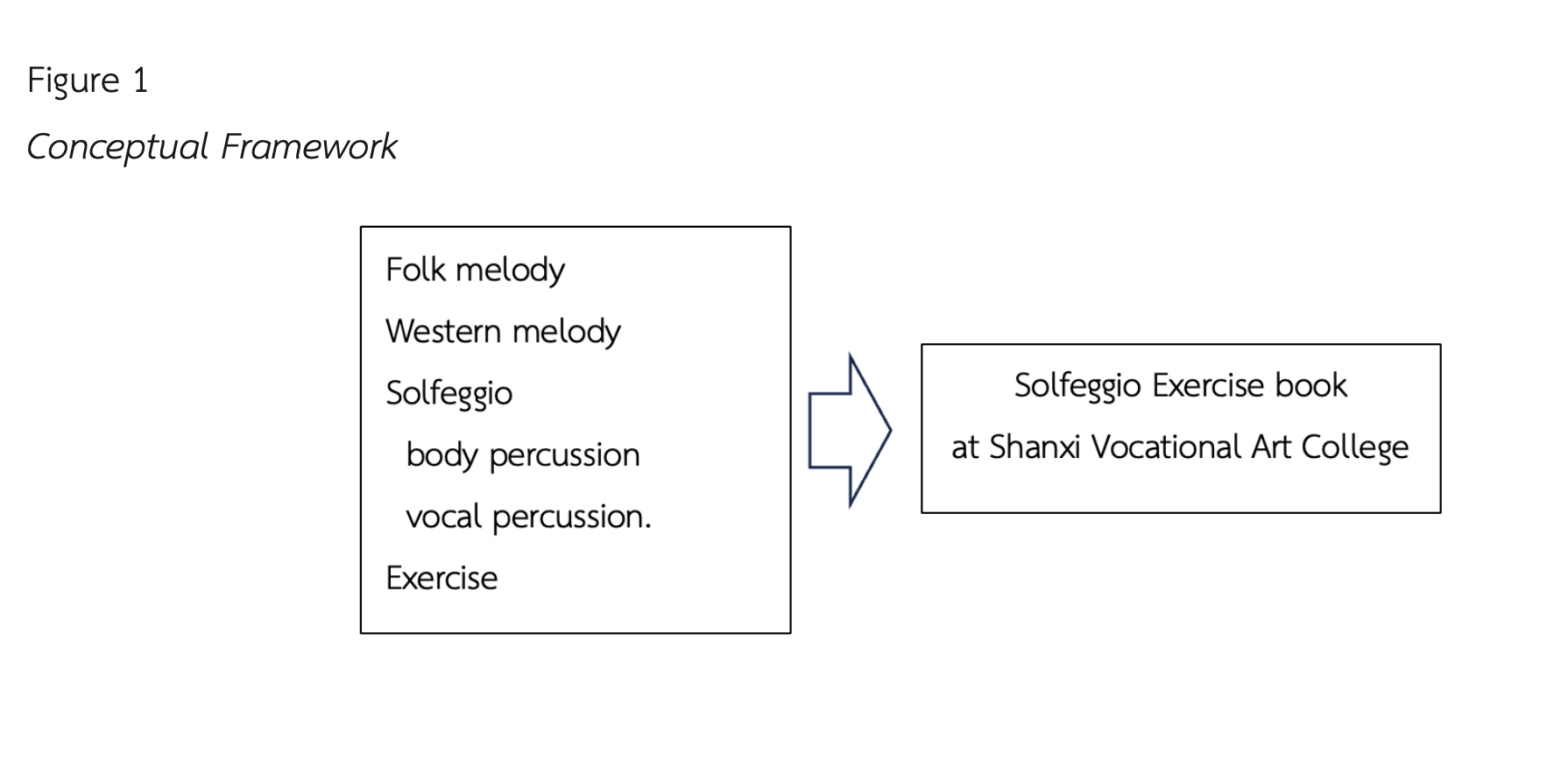A SOLFEGGIO EXERCISE BOOK FOR MUSIC STUDENT’S AT SHANXI ARTS VOCATIONAL COLLEGE, SHANXI TAIYUAN
Main Article Content
บทคัดย่อ
The purposes of this study were: 1) to study the folk and western melody for solfeggio exercise, and 2) to create the solfeggio exercise book for music students at Shanxi Vocational Art College. The research uses qualitative research to conduct in – depth interview. 5 experts were used to create a Solfeggio exercise book with 14 chapters, a teaching period of 14 weeks, and as a sample, a sample was tested using a practice test for 36 second-year students. Use analysis with descriptive analysis and basic statistics. Data was collected between March 2022 and June 2023.
The results of the research found that:
1) The singing and hearing ability in solfeggio with experts and study documents. Discovers that learners should learn the following contents principles: (1) Rhythm practice, (2) Pitch practice (scales), (3) Melodic memory (solfeggio pedagogy), (4) Folk melody solfeggio, and (5) Homework or practice.
2) The solfeggio exercise book, with a total of 14 units, including rhythm, pitch singing, listening and recognition 14 solfeggio exercises, with 180 minutes of teaching time per week.
Article Details
เอกสารอ้างอิง
Alsobrook, J. A. (2013). Music education in America: A content analysis and national perspective of
standards-based outcomes for K-8 general music [Doctoral dissertation, Lindenwood University].
ProQuest. https://www.proquest.com/docview/1427344534
Austin Rong-Da Liang. (2021). Examining the factors of experiential learning and teaching style: A case study
of a hospitality and tourism program. Journal of Hospitality, Leisure, Sport & Tourism Education
(2021).
Bin Li. (2017). Applications of Multimedia in Solfeggio Teaching. Advances in Social Science, Education and
Humanities Research, volume 171.
Chen, Y. (2022). Sight singing teaching based on Dalcroze's body rhythm [Master thesis, Nanjing University
of the Arts]. CNKI. https://wap.cnki.net/touch/web/Dissertation/Article/10331-1022692421.nh.html
Cleland, K. D., & Dobrea-Grindahl, M. (2010). Developing musicianship through aural skills: A holistic
approach to sight singing and ear training. Routledge. https://doi.org/10.4324/9780203861561
Duan, J. (2014). Research on the reconstruction of the curriculum system of music performance in ordinary
colleges and universities [Master thesis, Southwestern University]. CNKI.
https://wap.cnki.net/touch/web/Dissertation/Article/10635-1013265313.nh.html
Henry J. Quesada-Pineda, Erica Adams, and Hammett. A. L.Tom. (2011). Incorporating Experiential Teaching
Methods in Sustainable Natural Resources Curriculum: A Case Stud. Journal of Natural Resources
& Life Sciences Education • Volume 40 • 2011.
Ian R. Cornford. (2002). Reflective teaching: empirical research findings and some implications for teacher
education, Journal of Vocational Education & Training, 54:2, 219-236, DOI: 10.
/13636820200200196
Jiang, L. (2018). Practice and exploration of the training mode of music performance professionals in
colleges and universities. Musical Works, (3), 166-167. https://doi.org/10.3969/j.issn.
- 2436.2018.03.036
Karpushina, L. P., & Parshina, L. G. (2020). Development of ethno music hearing of students in the process
of folklore intonation. International Journal of Applied Exercise Physiology, 9(2), 48-54.
Liu, Z. (2019). Music creative thinking in music performance: On the cultivation of music creation ability of
music performance majors. Art Education, (9), 48-49.
Luo, Y. (2012). Research on academic performance evaluation of music performance majors in colleges
and universities [Doctoral dissertation, Shaanxi Normal University]. CNKI.
https://wap.cnki.net/touch/web/Dissertation/Article/10718-1012424691.nh.html
Mingdun, J. (2016). Introduction to Han folk songs. Shanghai Music Publishing House.
Petrovic, M. (2022). A New Concept of Teaching and learning abba’s songs in the university solfeggio
classroom. New Sound 59, I/2022.
Qian, Y. (2017). A phased and modular monophonic interval training method in the teaching of sight
singing ear training course. Journal of Mudanjiang College of Education, (10), 68-69.
https://doi.org/10.3969/j.issn.1009-2323.2017.10.025
Su, L. (2020). Research on training methods in sight-singing ear training courses: Take the multi-voice work
"Un Poquito Cantes" as an example [Master thesis, Changchun Normal University]. CNKI.
https://wap.cnki.net/touch/web/Dissertation/Article/10205-1020639430.nh.html
Sun, L. (2012). Exploration and thinking on the classification and graded teaching of sight singing ear
training courses in higher vocational college music colleges: Taking the teaching of Hebei Art
Vocational College as an example [Master thesis, Hebei Normal University]. CNKI.
https://wap.cnki.net/touch/web/Dissertation/Article/10094-1013122852.nh.html
Vidulin, S. (2022). The study of holistic listening to music in school: results and potential for further
research. Lzvirni znanstveni clanck· Original Scientific Article.
Wang, M. (2017). Research on new ideas for teaching ear training course for senior teachers:
Comprehensive practice experiential teaching method [Master thesis, Jilin Art College].
CNKI. https://wap.cnki.net/touch/web/Dissertation/Article/10209-1017261181.nh.html
Wang, Y. (2019). Analysis of musical expression based on multi-dimensional sight-singing thinking
[Master thesis, Central Conservatory of Music].
CNKI. https://wap.cnki.net/touch/web/Dissertation/Article/10045-1019200499.nh.html
William, G. Spady. (1994). Outcome-Based Education: Critical Issues and Answers(M). Arlington’VA
:American Association of School Administrators,1994.1.
Ye, S. (2016). Discussion on hearing discrimination training in sight-singing ear training teaching: A case study
of single tone, interval and chord listening training in sight-singing ear training course of teacher
training of X University Conservatory of Music as an example [Master thesis, Southwestern
University]. CNKI. https://wap.cnki.net/touch/web/Dissertation/Article/10635-1016766623.nh.html
Yiwen, W. (2019). Analysis of musical expression based on multi-dimensional sight-singing thinking [Master
thesis, Central Conservatory of Music]. CNKI. https://wap.cnki.net/touch/web/ Dissertation/Article/10045-1019200499.nh.html
Yu, Q. (2017). A phased and modular monophonic interval training method in the teaching of sight singing
ear training course. Journal of Mudanjiang College of Education, (10), 68-69.
https://doi.org/10.3969/j.issn.1009-2323.2017.10.025
Yuan, F. (2012). The relationship between technology and art: On the interaction between technical talent
and artistic accomplishment in music performance [Master thesis, Central Conservatory of Music].
CNKI. https://wap.cnki.net/touch/web/Dissertation/Article/10045-1013147131.nh.html
Zhou, Q. (2019). The use of Chinese folk songs in modern Chinese works [Doctoral dissertation, Shanghai
Conservatory of Music]. CNKI. https://wap.cnki.net/touch/web/Dissertation/Article/10278-
nh.html


